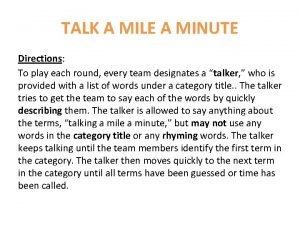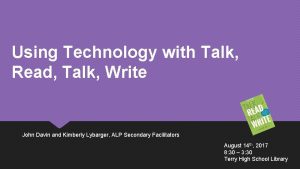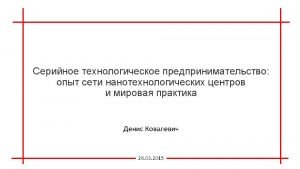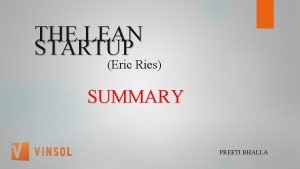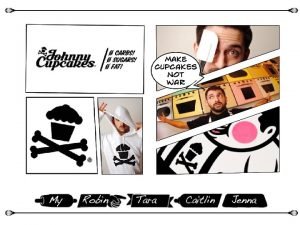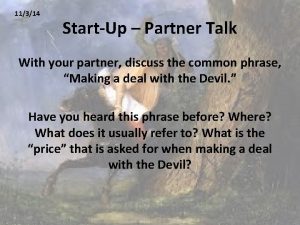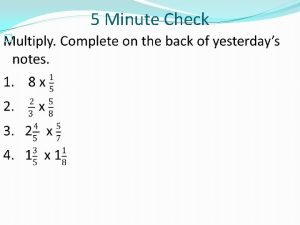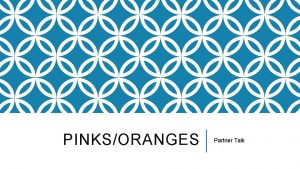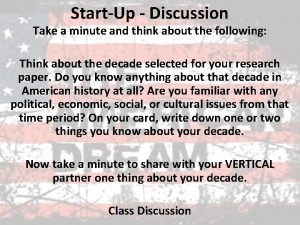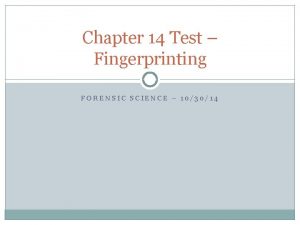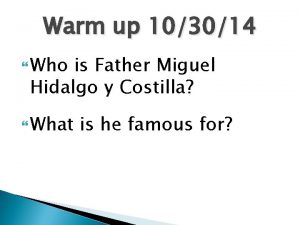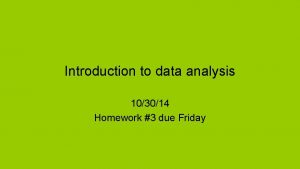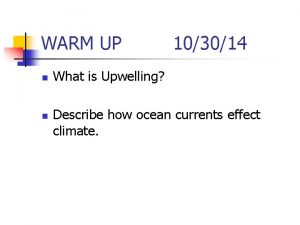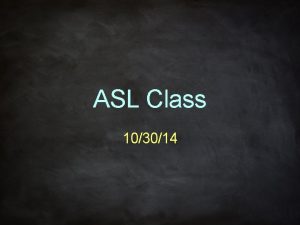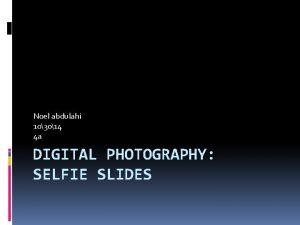103014 Startup Partner Talk Take a minute to
















- Slides: 16

10/30/14 Start-up – Partner Talk Take a minute to talk with your VERTICAL partner about this question: What is the scariest book you have ever read or movie you have ever seen? What was the setting of the story/movie? How did the writer/director set the mood?

Start-up – Writing Now write about what your PARTNER SAID! What is the scariest book you have ever read or movie you have ever seen? What was the setting of the story/movie? How did the writer/director set the mood? When you are finished writing, get your IR book and remove pages 117 -122. Return your book to the shelf.

Class Discussion • What is it in books and movies that contributes most to making us afraid? Is it surprise, gore, mood, something else? • Which do you find more frightening: books or movies? Why do you think that is?

Today’s Objective By the end of the period, students will be able to define and find examples of literary devices/figurative language/sound devices as used in the poem “The Raven” by Edgar Allan Poe (eg: refrain, internal rhyme, end rhyme, alliteration, onomatopoeia, and meter). CCSS. ELA-LITERACY. RL. 11 -12. 9

Vocabulary • On your own paper, create a double-entry journal. On one side will be the literary/sound devices we are about to discuss with their definitions. The other side will be examples of that device found in “The Raven. ” Literary/Sound device and definition Examples from “The Raven”

Vocabulary • Refrain – repeated lines • End rhyme – rhymes that occur at the ends of lines • Internal rhyme – rhyme that occurs within lines • Alliteration – repetition of a consonant sound • Onomatopoeia – use of words that imitate the natural sounds of the thing they name • Meter – regular pattern of stressed and unstressed syllables in a poem

Read/Listen to “The Raven” • Follow along in your IR pages as we listen to a reading of the poem. • Listen for those sound devices we just discussed. • If you hear any, underline or highlight them.

Independent Work • Now write the devices you heard in your double-entry journal next to the device/definition they show. • Read through the poem again to find any of the devices you may have missed during the first reading/listening. • Your completed double-entry journal is due tomorrow.

Exit Ticket • What sort of mood did Poe create in the poem “The Raven”? Did you find the poem scary? If so, what was it about it that you found scary? If not, why do you think it did not affect you in that way?

10/31/14 Start-Up – Partner Talk With your HORIZONTAL partner, discuss the following: What does the word “mood” mean to you? What does it mean, to you, to be “in a good mood” or “in a bad mood”? What do you think the word mood means in writing? How can a writer set a particular mood? BE PREPARED TO SHARE

Start-Up - Writing Think of a time when you were “in a bad mood. ” What happened? What was it about the situation that put you in that mood? What does being “in a bad mood” actually feel like? Describe the feelings.

Today’s Objective By the end of the period, students will be able to describe the mood of the poem “The Raven” by Edgar Allan Poe and analyze the word choices, images and literary devices the author uses to create that mood. They will compare the mood in the original writing to the mood created by a second version of the poem. CCSS. ELA-LITERACY. RL. 11 -12. 9 CCSS. ELA-LITERACY. RL. 11 -12. 7

What Is Mood • In literature, mood is a literary element that evokes certain feelings or vibes in readers through words and descriptions. • Usually, mood is referred to as the atmosphere of a literary piece, as it creates an emotional situation that surrounds the readers. • Mood is developed in a literary piece through various methods. It can be developed through: setting, imagery, theme, tone, and diction (word choice).

10 Minute Writing In one complete paragraph, no less than 5 sentences, answer the following question. How would you describe the mood, or feeling, created by the setting? Which images and literary devices in the beginning of the poem help create this mood?

Changing the Mood Check out this version of “The Raven. ” • In a second paragraph, discuss how the mood of this version is different from the mood of the original writing. What changed the mood?

Exit Ticket Which version of “The Raven” did you prefer: the original writing and audio from yesterday or the Simpsons version we saw today? What was it about it that made you like it more?
 One sixtieth of an hour or 60 seconds
One sixtieth of an hour or 60 seconds Talk a mile a minute
Talk a mile a minute Talk, read, talk, write resources
Talk, read, talk, write resources Amateurs talk strategy professionals talk logistics
Amateurs talk strategy professionals talk logistics Problem talk vs solution talk
Problem talk vs solution talk Arrestacaidas
Arrestacaidas Take a bus or take a train
Take a bus or take a train Startup business model
Startup business model Cp startup
Cp startup Your startup wants to implement an order fulfillment
Your startup wants to implement an order fulfillment Startup valuation damodaran
Startup valuation damodaran Habitual startup
Habitual startup Nvram_config
Nvram_config Summary lean startup
Summary lean startup Startup visa facilitator
Startup visa facilitator Busted tees models
Busted tees models Lean startup 101
Lean startup 101

